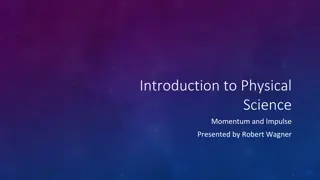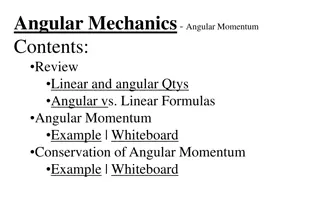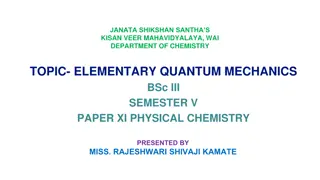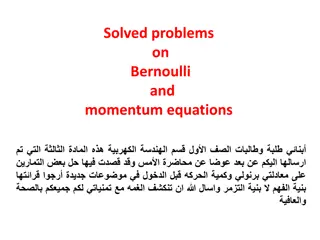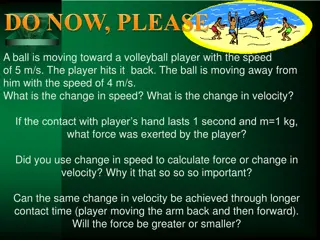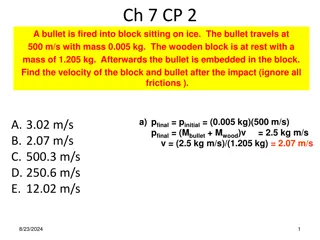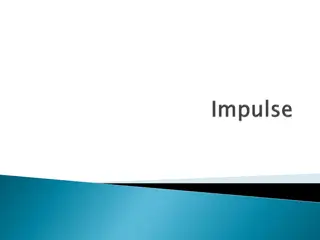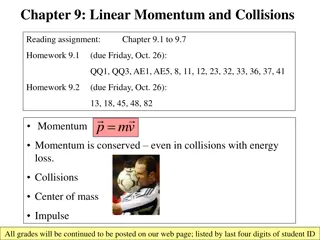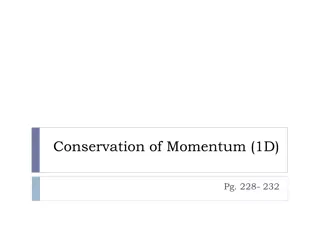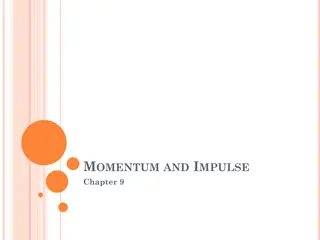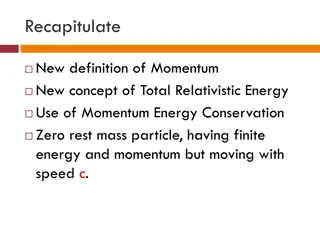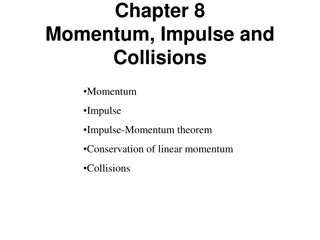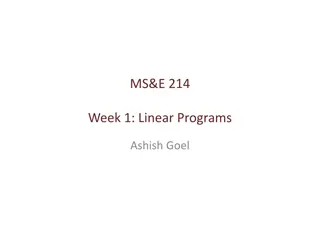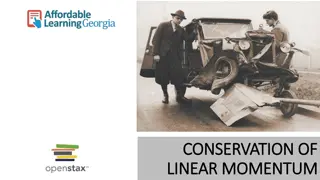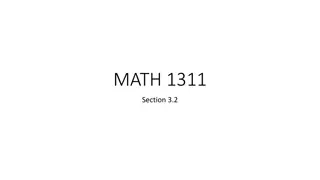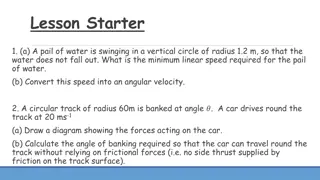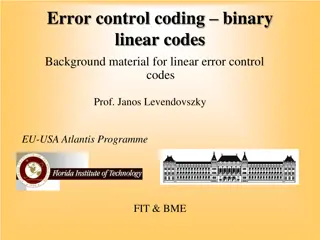Understanding Momentum and Impulse in Physical Science
Momentum and impulse play crucial roles in physical science, with momentum defined as mass multiplied by velocity and impulse as the change in momentum. This concept is explored through examples and discussions on Newton's Second Law and practical applications in everyday life, such as airbags in ca
3 views • 8 slides
Understanding Angular Momentum in Mechanics
Explore the key concepts of angular momentum in mechanics, including the difference between linear and angular quantities, angular momentum calculations, conservation principles, and practical examples illustrated on whiteboards. Delve into formulas, equations, and scenarios to grasp the fundamental
4 views • 27 slides
Angular Mechanics - Angular Momentum Concepts and Examples
Understanding angular momentum in mechanics involves reviewing linear and angular quantities, comparing angular to linear formulas, and exploring examples of angular momentum and conservation principles. The content covers key factors like angular quantities, torque, and moment of inertia, along wit
3 views • 23 slides
Heisenberg's Uncertainty Principle in Elementary Quantum Mechanics
Heisenberg's Uncertainty Principle, proposed by German scientist Werner Heisenberg in 1927, states the impossibility of simultaneously and accurately determining the position and momentum of microscopic particles like electrons. This principle challenges classical concepts of definite position and m
0 views • 49 slides
Understanding Linear Discrimination for Classification
Linear discrimination is a method for classifying data where examples from one class are separable from others. It involves using linear models or high-order functions like quadratic to map inputs to class separable spaces. This approach can be further categorized as class-based or boundary-based, e
3 views • 37 slides
Fluid Mechanics Problem Solving with Bernoulli and Momentum Equations
Explore solved problems related to Bernoulli and momentum equations in fluid mechanics, including calculations of discharge, velocity, flow types, pressure losses, and energy lines. Dive into scenarios involving conduit profiles, pipeline configurations, and Reynolds number calculations for water an
0 views • 21 slides
Understanding Momentum and Impulse in Sports
Momentum and impulse play a crucial role in sports performance. In a volleyball scenario where a ball is hit back by a player, understanding the change in speed, velocity, and force exerted can enhance gameplay strategies. Momentum is a key physics concept that affects an object's motion and the for
0 views • 40 slides
Understanding Linear Reservoir Baseflow Method
The linear reservoir baseflow method utilizes linear reservoirs to simulate the movement of water infiltrated into the soil. This method models water movement from the land surface to the stream network by integrating a linear relationship between storage and discharge. Users can select from one, tw
0 views • 11 slides
Understanding Linear Transformations and Matrices in Mathematics
Linear transformations play a crucial role in the study of vector spaces and matrices. They involve mapping vectors from one space to another while maintaining certain properties. This summary covers the introduction to linear transformations, the kernel and range of a transformation, matrices for l
0 views • 85 slides
Understanding Angular Momentum in Quantum Mechanics
Exploring the concept of total angular momentum in quantum mechanics, which involves the quantization of orbital and spin angular momenta. The coupling of these vectors leads to the formation of total angular momentum, with implications for the behavior of single-electron systems like the hydrogen a
0 views • 16 slides
Understanding Linear Programming: An Introduction to Optimization
Linear programming, introduced by mathematician George B. Dantzig in 1947, is a mathematical technique for optimizing resource allocation in a systematic manner. It involves formulating linear relationships among variables to achieve desired results like cost minimization or profit maximization. Lin
1 views • 60 slides
Understanding Momentum and Newton's Laws in Physics
Momentum is the product of mass and velocity, influencing an object's resistance to changes in motion. Newton's second law relates force to acceleration, while impulse is crucial in altering an object's momentum. Explore examples illustrating these concepts in action.
1 views • 9 slides
Comprehensive Overview of Numerical Linear Algebra Methods for Solving Linear Systems
Explore numerical linear algebra techniques for solving linear systems of equations, including direct and iterative methods. Delve into topics like Gaussian elimination, LU factorization, band solvers, sparse solvers, iterative techniques, and more. Gain insights into basic iterative methods, error
6 views • 12 slides
Understanding Linear and Rotational Motion in Physics
Explore the concepts of linear momentum, center of mass, rotational motion, and angular displacement in physics. Learn how to determine the center of mass of objects, analyze motion of particle groups, and understand the conservation of momentum in systems under external forces. Delve into the funda
0 views • 18 slides
Understanding Momentum in Physics
Explore the concept of momentum in physics through scenarios involving collisions and rotational displacement. Learn how momentum is conserved in different situations and its impact on the final direction of motion. Discover the relationship between velocities, masses, and changes in momentum in var
0 views • 31 slides
Understanding Impulse and Momentum in Physics
Impulse, defined as the force times the time over which it acts, is crucial in changing an object's momentum. Various scenarios such as golf impact, billiard ball collisions, and skateboard acceleration are explored to demonstrate the importance of force, time, and impulse in physics concepts. Learn
14 views • 9 slides
Physics Applications: Momentum, Impulse, and Recoil Calculations
Explore various physics scenarios involving momentum, impulse, and recoil in this collection. Calculate the impulse of net force, average net force, recoil velocity of a rifle, and initial speed of a bullet using principles of conservation of momentum. Solve problems related to multi-dimensional imp
0 views • 5 slides
Understanding Linear Momentum and Collisions in Physics
Exploring the concepts of linear momentum, collisions, and conservation of energy in physics, this content covers topics such as momentum definition, conservation laws, impulse, types of collisions, and examples of perfectly inelastic and elastic collisions. It also includes a practical blackboard e
0 views • 17 slides
Understanding Momentum and Collisions in Physics
Momentum plays a crucial role in analyzing collisions, where objects exert forces on each other over short time intervals. Conservation of momentum, following Newton's laws, allows predicting outcomes in collisions by redistributing momentum among objects. The concept is illustrated through examples
0 views • 25 slides
Understanding Conservation of Momentum in Physics
Conservation of momentum in physics addresses how the total momentum of a system remains constant in a collision or interaction between objects. Newton's Third Law and the law of conservation of momentum play key roles in explaining the transfer of momentum between objects during collisions. Momentu
0 views • 11 slides
Understanding Linear Impulse and Momentum in Mechanics
Explore the principles of linear impulse and momentum, conservation of linear momentum, mechanics of impact, and more in this study module. Learn to analyze forces, solve problems involving fluid streams and propulsion, and apply these concepts to real-world scenarios. Engage in practical problem-so
0 views • 23 slides
Understanding Momentum and Impulse in Physics
Explore the concepts of momentum and impulse in physics, including the definition of momentum, the impulse-momentum theorem, and how factors affect object motion post-collision. Discover how momentum plays a vital role in describing an object's motion and learn about the relationship between force,
0 views • 30 slides
Understanding Linear Dependent and Independent Vectors
In linear algebra, when exploring systems of linear equations and vector sets, it is crucial to distinguish between linear dependent and independent vectors. Linear dependence occurs when one vector can be expressed as a combination of others, leading to various solutions or lack thereof in the give
0 views • 20 slides
Understanding Relativistic Energy and Momentum in Particle Physics
Discuss the new definition of momentum and the concept of total relativistic energy. Explore the use of momentum-energy conservation in scenarios involving zero rest mass particles. An example of an inelastic collision is provided to demonstrate the application of these principles.
0 views • 51 slides
Understanding Momentum, Impulse, and Collisions in Physics
Learn about momentum, impulse, and collisions in Chapter 8 of physics. Understand how linear momentum, impulse, and the Impulse-Momentum theorem are crucial in analyzing collisions and conservation of momentum. Explore real-world applications in sports and scenarios like a child driving a bumper car
0 views • 19 slides
Converting Left Linear Grammar to Right Linear Grammar
Learn about linear grammars, left linear grammars, and right linear grammars. Discover why left linear grammars are considered complex and how right linear grammars offer a simpler solution. Explore the process of converting a left linear grammar to a right linear grammar using a specific algorithm.
0 views • 44 slides
Understanding Linear Optimization in MS&E 214
Linear optimization involves maximizing or minimizing a linear function subject to constraints. This week's focus in MS&E 214 is on linear programming, basic feasible solutions, duality theory, and extreme point solutions. The concept of linear programs, such as the example of maximizing x + 3y subj
0 views • 36 slides
Momentum and Collisions Explained Through Illustrations
Explore various scenarios involving momentum, collisions, and elastic interactions through illustrated examples. Understand concepts such as total momentum in different situations, speeds of masses after collisions, momentum conservation in 1-D and 2-D collisions, and changes in momentum direction.
0 views • 28 slides
Adapting Linear Hashing for Flash Memory Constrained Embedded Devices
This research explores the adaptation of linear hashing for improved data handling on flash memory-constrained embedded devices. Motivated by the increasing data collection by IoT devices, the study focuses on implementing database structures like a linear hash table for efficient data processing. T
0 views • 67 slides
Conservation of Momentum in Collisions: University of Ottawa Physics Lab
Study the conservation of linear momentum and energy in elastic and inelastic collisions in one dimension at the University of Ottawa's physics lab. Analyze the motion of gliders on an air track, observe changes in velocity, momentum, and energy, and compare position-time and velocity vs. time graph
0 views • 15 slides
Understanding Energy Conversion, Power, and Momentum in Physics
Exploring the concepts of energy conversion between potential and kinetic energy, the importance of power in work efficiency, and the role of momentum and impulse in describing motion in physics. The discussion covers elastic forces, work done, power calculations, examples of watt and joules, as wel
0 views • 28 slides
Understanding Conservation of Linear Momentum
Explore the concept of conservation of linear momentum, principles, and applications like isolated systems, internal forces, and recoil of a rifle. Learn how total momentum remains constant in a closed system where external forces sum up to zero.
0 views • 6 slides
Understanding Linear Functions in Mathematics
Linear functions play a crucial role in mathematics, focusing on elements like rate of change and initial value. Through examples involving daily car rental costs and profit from selling birdhouses, this content explores the concept of linear functions and how they are applied in real-life scenarios
0 views • 13 slides
Understanding Momentum and Impulse in Physics
Momentum is the product of an object's mass and velocity, while impulse is the change in momentum resulting from a force acting over time. By applying force for a longer duration, momentum can be increased or decreased effectively. The relationship between impulse and momentum is crucial in understa
0 views • 26 slides
Understanding Momentum and Impulse in Physics
Momentum, defined as mass x velocity, and impulse, the change in momentum resulting from a force over time, are essential concepts in physics. This chapter explores how momentum can be altered through changes in mass or velocity and how impulse affects momentum. The relationship between force, time,
0 views • 27 slides
Understanding Angular Momentum in Physics
Learn about the concept of angular momentum in physics through practical examples and explanations. Explore how angular momentum is conserved in rotating bodies and how it impacts various sports activities. Discover the relationships between moment of inertia, angular velocity, and conservation of a
0 views • 19 slides
Understanding Momentum in Physics
Momentum, first introduced by Isaac Newton, is symbolized by the letter p and signifies inertia in motion. It is calculated as mass multiplied by velocity (p = m * v) and has the unit of kg * m/s. The amount of momentum depends on the object's mass and speed. A moving object has more momentum if eit
0 views • 18 slides
Understanding Linear and Nonlinear Functions in Mathematics
Explore the concepts of linear and nonlinear functions in mathematics through identifying linear and nonlinear functions from graphs, understanding the characteristics of linear functions, and identifying linear functions from tables. Learn about the constant rate of change, slope, and how to determ
0 views • 49 slides
Understanding Linear Error Control Coding and Syndrome Detection in Binary Linear Codes
Delve into the world of linear error control coding, guided by Prof. Janos Levendovszky, as we explore the development of linear codes, message vectors, error groups, and the process of selecting group leaders with detailed examples. Discover how syndrome detection and decoding tables play a crucial
0 views • 27 slides
Understanding Zonal Momentum Balance in the Antarctic Circumpolar Current
This study investigates the zonal momentum balance of the Antarctic Circumpolar Current (ACC) by analyzing the interplay between wind stress, topographic form stress, and eddy dynamics. The research explores the maintenance and adjustment of momentum balance in the ACC, emphasizing the roles of baro
0 views • 10 slides
